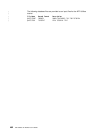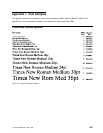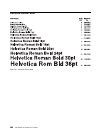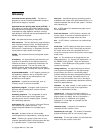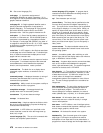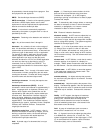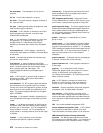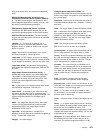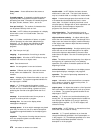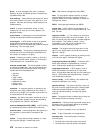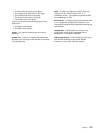CL. See
control language (CL)
.
code page. (1) A particular assignment of
hexadecimal identifiers to graphic characters. (2) In
AFP support, a font file that associates code points and
graphic character identifiers.
code-page ID. A 5-digit registered identifier used to
specify a particular assignment of code points to
graphic characters. The code-page ID is the second
part of the QCHRID system value or the CHRID
parameter value. See also
graphic character-set ID
.
code point. (1) One of the bit patterns assigned to a
character in a character set. On the AS/400 system, a
code point is represented by a hexadecimal number.
For example, in code page 256 (EBCDIC), the letter “e”
is assigned a code point of hex 85. (2) In AFP support,
an 8-bit binary number representing one of 256
potential characters.
coded font. In AFP support, a font file that associates
a code page and a font character set. For double-byte
fonts, a coded font associates multiple pairs of code
pages and font character sets.
command. (1) A statement used to request a function
of the system. A command consists of the command
name abbreviation, which identifies the requested
function, and its parameters. starts a protocol.
command line. The blank line on a display where
commands, option numbers, or selections can be
entered.
command prompt. A displayed character (or string of
characters) that indicates that a user may enter a
command to be processed.
compatibility. Ability to work in the system or ability to
work with other devices or programs.
completion message. A message that tells the
operator when work is successfully ended.
concatenate. To join two character strings.
concept. An abstract idea.
contextual help. Help that explains the field on which
the cursor is positioned when you press the Help key.
Contrast with
extended help
.
control field. In AFP Utilities, an input field on the
screen view that is used to move the image area up,
down, left, or right.
control language (CL). The set of all commands with
which a user requests system functions.
control language (CL) program. A program that is
created from source statements consisting entirely of
control language commands.
cpi. See
characters per inch (cpi)
.
current library. The library that is specified to be the
first user library searched for objects requested by a
user. The name for the current library can be specified
on the Sign-On display or in a user profile. When you
specify an object name (such as the name of a file or
program) on a command, but do not specify a library
name, the system searches the libraries in the system
part of the library list, then searches the current library
before searching the user part of the library list. The
current library is also the library that the system uses
when you create a new object, if you do not specify a
library name.
current release. The latest available release of the
system that replaced the licensed internal code and/or
the operating system.
cursor. A movable symbol, often a blinking or solid
block of light, that tells the display station user where to
type, or identifies a choice to select.
data area. A system object used to communicate data,
such as CL variable values between the programs
within a job and between jobs. The system-recognized
identifier for the data area is *DTAARA.
data integrity. (1) The condition that exists as long as
accidental or intentional destruction, alteration, or loss
of data does not occur. (2) Within the scope of a unit
of work, either all changes to the database
management systems are completed or none of them
are. The set of change operations are considered an
integral set.
data management. The part of the operating system
that controls the storing and accessing of data to or
from an application program. The data can be on
internal storage (for example, database), on external
media (diskette, tape, or printer), or on another system.
data stream. All information (data and control
commands) sent over a data link usually in a single
read or write operation.
data tower. In AFP Utilities, a set of intelligent printer
data stream commands that represent a data type, such
as text, image, graphics, and bar code.
database. All the data files stored in the system.
database file. One of several types of the system
object type *FILE kept in the system that contains
descriptions of how input data is to be presented to a
program from internal storage and how output data is to
470 AFP Utilities for AS/400 User’s Guide



